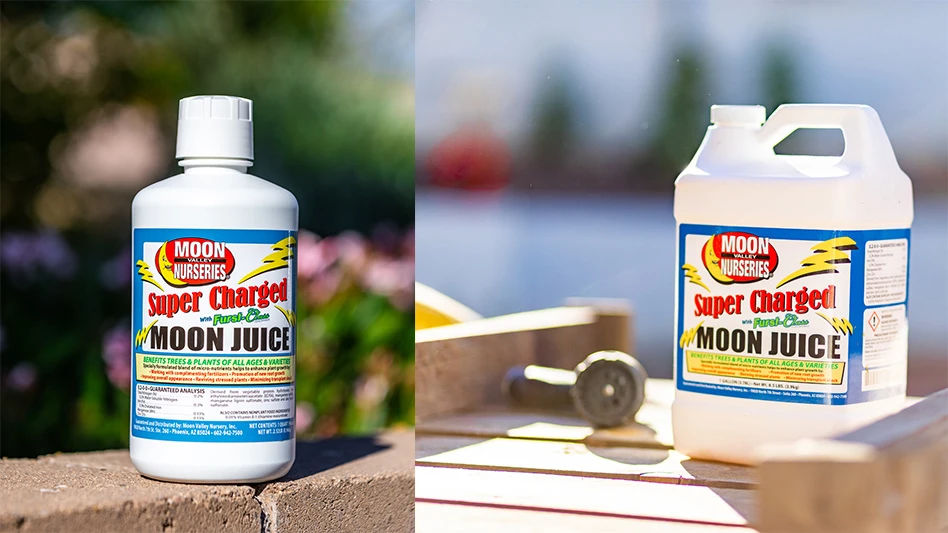 The center plant, partially resistant cultivar Buxus harlandii, was direct inoculated with 10,000 Cylindrocladium buxicola spores per ml until runoff on April 11. Then healthy, uninfected B. sempervirens ‘Suffruticosa’ were placed next to the test plant. This photograph was taken May 28. |
Boxwood blight is a foliar disease of boxwood caused by the fungal pathogen Cylindrocladium buxicola (=Calonectria pseudonaviculata). Prior research has shown that the popular boxwood cultivars Buxus sempervirens ‘American’ and ‘Suffruticosa’ (English) are highly susceptible to the pathogen.
In the summer of 2012, we performed a study to identify boxwood cultivars with resistance to boxwood blight (see sidebar). Several commercial cultivars were identified as partially resistant (or tolerant) to the disease, due to minimal symptom and disease development. When exposed to C. buxicola, these cultivars remained healthy and expressed limited leaf lesions, stem cankers, and dieback.
The Trojan Horse study was conducted to determine the ability of these partially-resistant boxwood cultivars to serve as sources of inoculum for the pathogen, thus being capable of initiating infection in blocks of susceptible boxwood cultivars. We decided to call this the ‘Trojan Horse Experiment’ because we wanted to identify if boxwood blight could be introduced to a landscape or production area disguised like the Greeks in the infamous Trojan horse story. We hypothesized that apparently healthy, partially resistant cultivars with C. buxicola infection could serve as inoculum reservoirs which would contribute to infections and blight outbreaks in more susceptible cultivars.
The cultivars The trial was conducted in a self-contained, shaded lathe house with overhead irrigation in Raleigh, N.C. during April and May 2013. The partially resistant test plants included B. harlandii, B. microphylla ‘Golden Dream,’ B. microphylla ‘John Baldwin,’ B. microphylla var. japonica ‘Green Beauty,’ B. microphylla ‘Winter Gem,’ B. sinica var insularis ‘Nana,’ and Buxus ‘Green Gem.’ The test plants in the study were exposed to the fungus in two ways: 1) prior exposure to C. buxicola by both direct spray (1,000 spores per ml) and indirect (test plants were placed next to heavily infected ‘Suffruticosa’ plants) inoculation during the summer of 2012; and 2) recent exposure to C. buxicola by direct spray-inoculation of 10,000 spores per ml until run-off. The study included ‘Suffruticosa’ positive control plants which were direct spray-inoculated until run-off with either 10,000 spores per ml, 1,000 spores per ml, or water. Healthy, uninfected ‘Suffruticosa’ plants were placed on both sides of each partially-resistant test cultivar to serve as disease indicator plants. Disease evaluations were performed May 2, May 10 and May 28 using a modified Horsfall-Barratt rating scale. Partially-resistant test plants which were recently inoculated with the pathogen in April 2013 were generally more effective at transmitting the pathogen to healthy ‘Suffruticosa’ plants than the test plants that were exposed to the pathogen during the summer of 2012.
The results From May 18-23, the Raleigh area received more than 2 inches of rain with an average daily temperature of 72°F–extremely conducive conditions for boxwood blight. Due to the climate, high inoculum production on infected plants in the experiment, and inoculum transmission via wind-driven rain, some of the uninoculated ‘Suffruticosa’ negative control plants (spaced 3 feet from infected reservoir plants) were also infected with C. buxicola. Inter-plot interference from the inoculated ‘Suffruticosa’ positive control plants may have contributed to some disease development on the negative controls and the disease indicator plants. However, our data suggests that the partially-resistant boxwood cultivars we tested with minimal boxwood blight symptom development may be capable of transmitting the pathogen to healthy, susceptible cultivars.
|
Box Blight Susceptibility Susceptibility to box blight (Cylindrocladium buxicola = Cylindrocladium pseudonaviculatum) was evaluated for 23 varieties of boxwood (Buxus spp.) at the Mountain Horticultural Crops Research and Extension Center in Mills River, N.C., during summer 2012. Disease assessments were performed based on a modified Horsfall-Barratt scale including percent leaf area diseased and percent stem streaking. The results shown below are based on the final disease assessment. Our results indicate a wide range in susceptibility of Buxus spp. to the boxwood blight pathogen; however B. sempervirens types were more susceptible in general (a 2011 publication reported ‘Justin Brouwers’ to actually fall within the B. sempervirens cluster). The varieties listed as tolerant had minimal lesion development caused by C. buxicola. It is important to note that some boxwood varieties are limited in their optimal plant hardiness zones. Highly susceptible
Susceptible
Moderately susceptible
Moderately tolerant
Tolerant
|
Miranda Ganci is a graduate student, Mike Benson is a professor and Kelly Ivors is an associate professor and extension specialist at the Department of Plant Pathology, NCSU; Kelly_Ivors@ncsu.edu.
Get curated news on YOUR industry.
Enter your email to receive our newsletters.
Explore the August 2013 Issue
Check out more from this issue and find your next story to read.
Latest from Nursery Management
- Society of American Florists accepting entries for 2025 Marketer of the Year Contest
- Sustainabloom launches Wholesale Nickel Program to support floriculture sustainability
- American Horticultural Society welcomes five new board members
- Get to know Christopher Brown Jr. of Lancaster Farms
- American Floral Endowment establishes Demaree Family Floriculture Advancement Fund
- The Growth Industry Episode 3: Across the Pond with Neville Stein
- The Growth Industry Episode 2: Emily Showalter on how Willoway Nurseries transformed its business
- March 2025 issue recap





